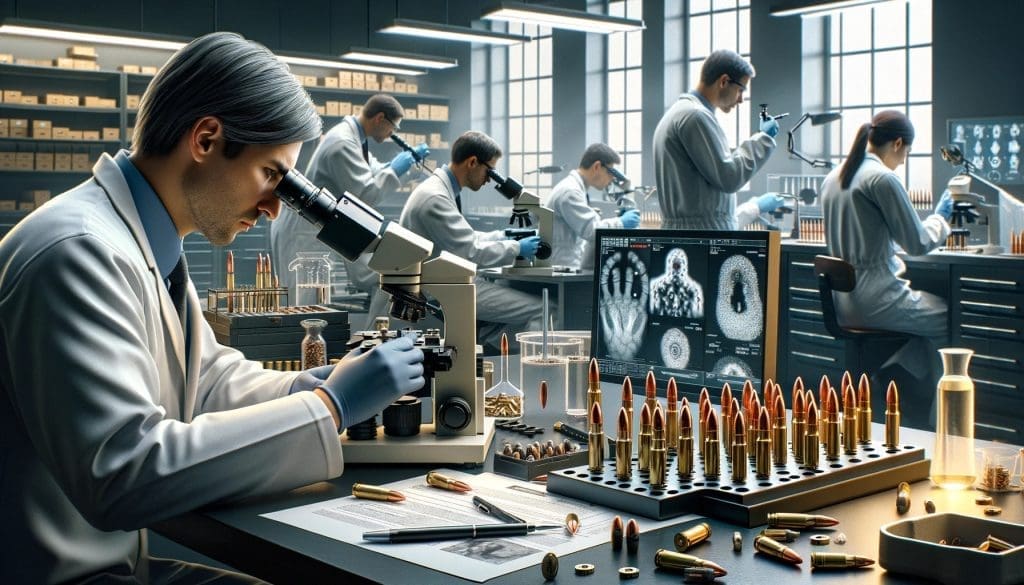Forensic Ballistics: Deciphering Crimes in the Legal Arena
Forensic ballistics, a crucial branch of forensic science, plays a pivotal role in criminal investigations and the justice system. By applying principles of mechanics to the study of bullets, firearms, and other projectiles, this discipline aids in unraveling crimes and presenting scientifically sound evidence in legal proceedings.
The essence of forensic ballistics lies in its ability to establish connections between a bullet and the firearm from which it was fired. This process, often referred to as ballistic fingerprinting, hinges on the understanding that each firearm leaves unique marks on the ammunition it discharges. These marks, akin to fingerprints, are created by the grooves inside the barrel of a firearm which impart a spin to the bullet, enhancing its flight accuracy. No two firearms have identical patterns, making it possible for forensic experts to match a bullet to a specific weapon.
In crime scene investigations, forensic ballistics extends its utility beyond identifying firearms. It plays a significant role in reconstructing events, determining firing distances, and tracing bullet trajectories. When a firearm is discharged, it expels not only the bullet but also gunpowder residues, leaving distinctive patterns on nearby surfaces. Analyzing these patterns helps forensic experts ascertain the approximate distance from which a shot was fired. Such analysis can be crucial in differentiating between self-inflicted injuries and homicides.
Modern techniques in forensic ballistics include the use of lasers for precise trajectory analysis and the examination of bullets under microscopes to identify unique rifling marks. Additionally, experts often resort to comparison microscopy, a method that involves comparing a questioned bullet or cartridge case with a known sample to determine if they were fired from the same firearm.
Despite its invaluable contributions, forensic ballistics is not without challenges. Variability in tool marks, subjectivity in interpretation, and the lack of standardized protocols across different laboratories can pose difficulties in definitively linking a bullet to a specific firearm. Additionally, the effectiveness of ballistic analysis relies heavily on comprehensive and up-to-date databases of firearms, which may not be available in all jurisdictions.
The legal system widely recognizes the role of forensic evidence, including ballistics, in the trial of criminal offenders. The scientific nature of ballistic evidence minimizes biases, making it a powerful tool in the pursuit of justice. The importance of forensic ballistics is further underscored by the fact that, without it, linking a suspect to a crime involving firearms would be significantly more challenging.
The historical development of forensic ballistics traces back to the early 20th century. One of the significant figures in this field was Calvin Goddard, often regarded as the father of forensic ballistics. He pioneered the use of the comparison microscope for examining bullets in the 1920s. This allowed for the comparison of bullets and shell casings found at crime scenes to those test-fired from suspected firearms, revolutionizing the way firearm-related evidence was analyzed.
Technological advancements have significantly enhanced the capabilities of forensic ballistics. Modern techniques include computerized ballistic identification systems like the Integrated Ballistic Identification System (IBIS) and the Ballistic Identification System (BIS). These systems can analyze and compare markings on bullets and shell casings, facilitating quicker and more accurate matches. Advances in 3D imaging and laser scanning have also improved the precision of trajectory analysis and bullet path reconstruction.
Several case studies highlight the role of forensic ballistics in solving crimes. One famous case is the assassination of President John F. Kennedy, where ballistic evidence played a crucial role in the investigation. Forensic ballistics was instrumental in determining the number of shots fired and the trajectory of the bullets, which helped in piecing together the events of that fateful day.
The role of ballistics extends beyond criminal investigations to civil cases as well. In incidents involving accidental shootings or disputes over firearm usage, ballistic evidence can provide insights into the nature of the incident, potentially affecting the outcome of civil litigation or insurance claims. In wrongful death suits involving firearms, for instance, ballistic evidence can determine whether the death was accidental or intentional, which can significantly influence the legal proceedings.
In summary, the evolution of forensic ballistics has had a profound impact on both criminal and civil law. Its historical development, coupled with technological advancements, has made it an indispensable tool in the legal system, providing crucial evidence that can make or break a case. As technology continues to advance, so too will the capabilities and applications of forensic ballistics in legal contexts.
In conclusion, forensic ballistics is an indispensable tool in modern criminal investigations. It bridges the gap between law enforcement and scientific analysis, offering critical insights into criminal activities involving firearms. As technology advances, so too will the methods and accuracy of forensic ballistics, further cementing its role in the criminal justice system.
To explore more about the history, advancements, and case studies in forensic ballistics, you might find the following sources informative:
- Simply Forensic – Forensic Ballistics
- IFF Lab – The Importance of Forensic Science in Criminal Investigations and Justice













